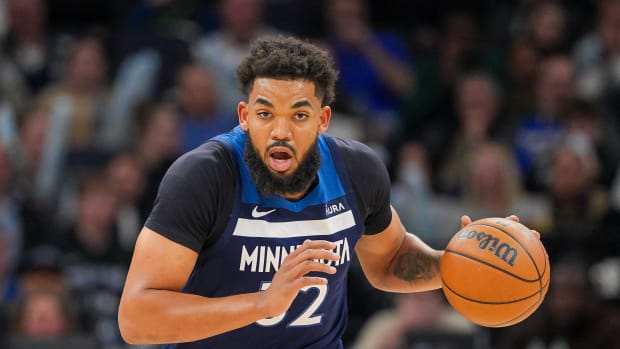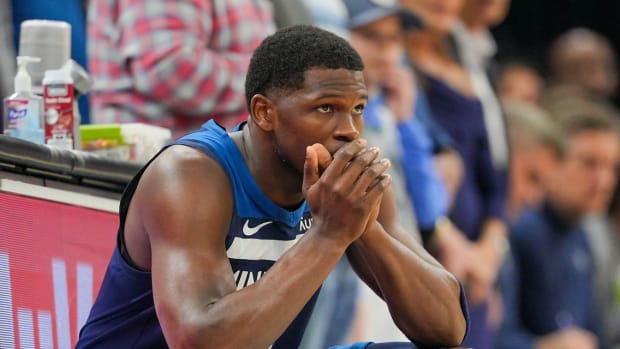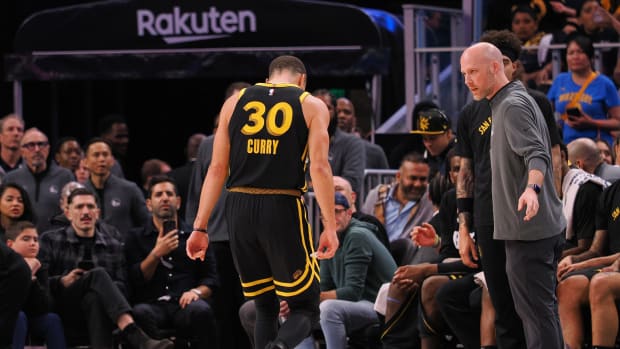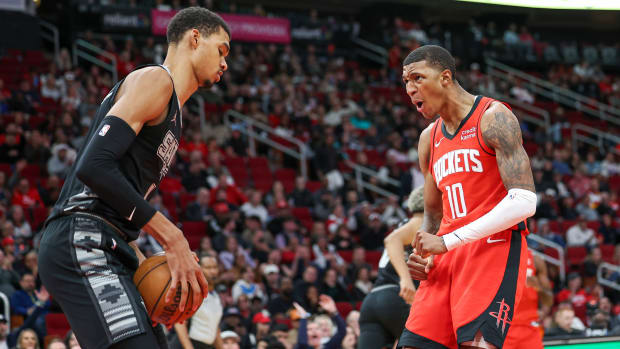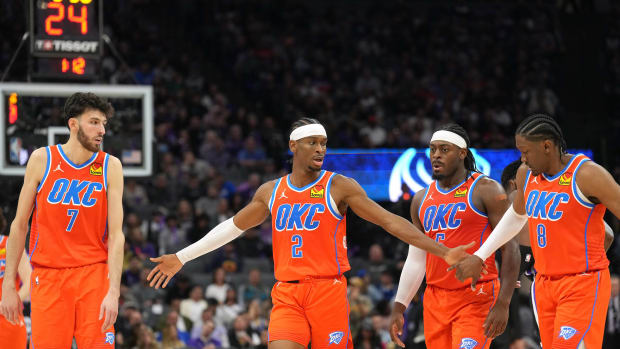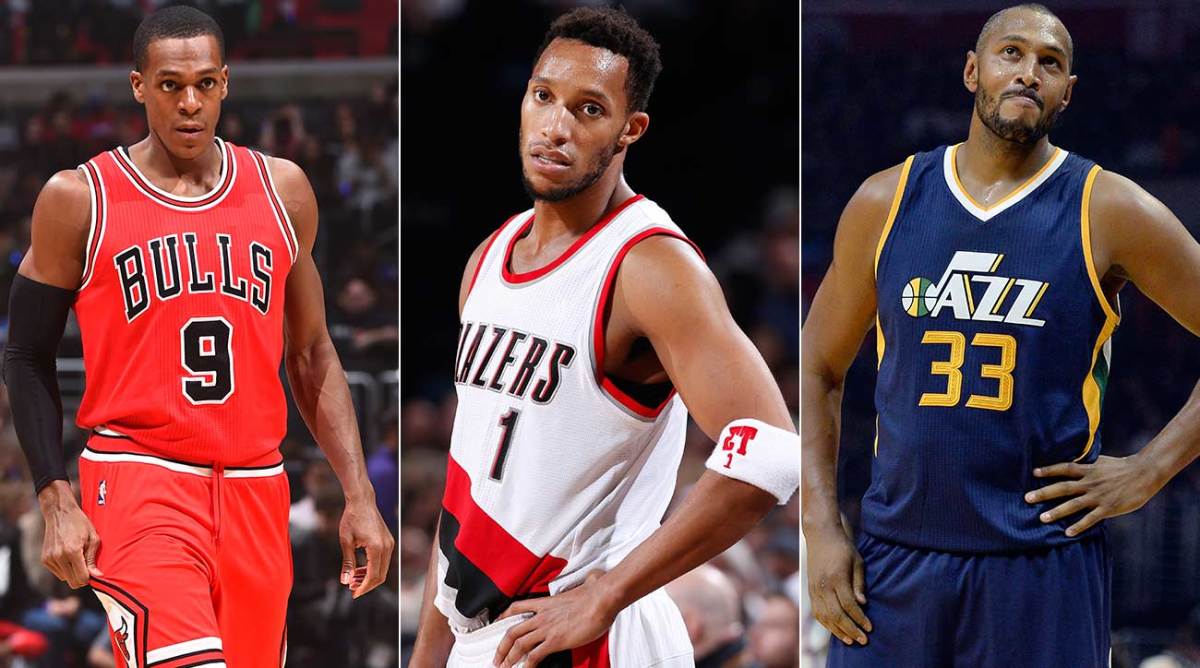
Buyer's Remorse? Five New Additions Off To Regrettable Starts
Thanksgiving week is upon us, which means the first month of the 2016-17 NBA season is nearly in the books. Given that 10 teams are entering Monday’s action within one game of .500, it’s best to hold back from making any damning judgments. Still, the sample size has grown large enough that problematic areas and weak links have begun to show.
With that in mind, here’s a look at five notable players off to rocky starts after changing teams this summer.
(All stats and records through Nov. 20.)
Evan Turner, Trail Blazers
Well, let’s go ahead and start at the bottom. Evan Turner’s four-year, $70 million contract has probably incited more second-guessing than any other deal from the record-setting summer of 2016, and it’s easy to see why. Turner ranks 407th out of 407 eligible players by ESPN’s Real Plus-Minus metric (-5.97), he ranks dead last in raw plus-minus (-131), and he’s shooting an anemic 35.2%. Portland tapped Turner as the leader of its revamped second unit with the hope that his playmaking might consistently alleviate pressure on Damian Lillard and CJ McCollum. Instead, the Blazers (8-7) have a bottom-five bench in terms of scoring and efficiency differential, per HoopsStats.com, creating wild swings in night-to-night performance and contributing to an unimpressive -5.7 point differential.
The fit concerns that arose immediately after Turner’s signing this summer have largely played out to the worst-case scenario. While Turner’s lack of perimeter shooting has been a major issue, perhaps the larger concern is his preferred pace of play. Blazermaniacs have become accustomed to the “Flow” style under coach Terry Stotts, where bodies move off the ball and the ball in turn moves to find them once they’re open. Turner is a “groove” player, most comfortable when he’s rocking defenders with the dribble and looking for openings in one-on-one situations. There might come a time when the flow and groove meet to produce magic, but so far they have rubbed like sandpaper. This friction, no doubt, is exacerbated by a lack of familiarity with his new teammates. Cue up tape of Turner’s turnovers, and there are passes to cutters who never cut and kick outs to teammates who aren't there. Not to mention the clips of guys standing around confused as Turner over-dribbles through defensive traffic without a clear exit strategy.
Is Greg Oden Really The NBA's Biggest Draft Bust?
Portland’s blowout win over Brooklyn on Sunday provided a blueprint for a more functional Turner, as he found his shooting stroke from the mid-range (an absolute necessity) and struck a better balance as a playmaker. Even if Turner gets going offensively, though, a larger question will remain: Shouldn’t his money have been spent elsewhere addressing other areas of concern? Given that Portland currently ranks dead last in defensive efficiency and rebound rate and that defensive-minded center Festus Ezeli remained sidelined due to injury, the answer to that question looks like a resounding yes. Al-Farouq Aminu’s absence has submarined the Blazers’ defensive numbers, but even at full strength this group has been overmatched inside. It’s still (very) early, but the Blazers’ hopes of making a repeat trip to the second round might very well hinge on the front office’s ability to make a roster-balancing trade before the February deadline.
Rajon Rondo, Bulls
After the Bulls spent Fred Hoiberg’s rookie season badly underperforming, Year Two is off to a fairly promising start. Jimmy Butler deserves first crack at the credit, as he ranks third overall in Real Plus Minus and has easily outperformed fellow East All-Star wings like Paul George and DeMar DeRozan when it comes to all-around impact. Then comes Dwyane Wade, whose smooth assimilation has given Butler a legitimate running mate and the Bulls a savviness they were lacking. From there, dumping both Derrick Rose and Joakim Noah have proven to be strong addition by subtraction plays. Throw in Robin Lopez’s trademark gumption and Chicago (9-5) is on to something.
However, there is one unresolved hiccup: Rajon Rondo. If there was one move during Chicago’s busy summer that truly raised doubts about the franchise’s direction, it was giving Rondo another chance”after thoroughly unimpressive exits in Boston, Dallas and Sacramento. The polarizing point guard is off to a rinse-repeat start: Despite gaudy assist numbers, his offensive impact is minimal, his defensive impact is atrocious, and his lack of shooting is inescapable.
As the Bulls blew a 19-point lead to the Clippers in L.A. on Saturday, Rondo’s shortcomings were on full display: He zipped a pass into the courtside seats on a critical late possession, he lost track of his defensive assignment too many times to count, and his space-killing presence made Chicago’s offense significantly easier to stop. Unfortunately for Chicago, the damage isn’t merely anecdotal. Rondo ranks dead last among starting guards with a 40.6 True Shooting Percentage, his 108.2 defensive rating is easily a team-worst, and his Real Plus Minus (-2.99) ranks 29th among starting point guards. Fittingly, only Rose (-4.06) is worse.
What Will The NBA Look Like In 2020?
For what it’s worth, Chicago’s loss in L.A. was an especially competitive game for November, one that ended in controversy and saw Hoiberg earn his first career ejection. While it might be going too far to call any game this early a “playoff preview,” the loss was a reminder of how costly Rondo’s presence will be on the postseason stage, once defenses are scheming to completely neglect him and his lapses in awareness go under the microscope.
The most intriguing aspect of this situation is that Hoiberg has Rondo-free options at his disposal. Butler and Wade can function as initiators, and their shared ability to collapse defenses sets up Chicago’s complementary options just as well as a laser from Rondo. Meanwhile, Jerian Grant, a throw-in to the Rose deal, showed flashes when Rondo was sidelined last week and Michael Carter-Williams, acquired from the Bucks in an October trade, is expected to return from a knee injury in the near future. Isaiah Canaan has chipped in minutes too.
After one month, and with years of Rondo evidence as a guide, it’s probably safe to pack the “Three Alphas” talk away in the attic for good and start thinking of this as "The Butler and Wade Show." For Rondo, marginalization has historically been a pill too bitter to swallow without a fight. For the Bulls, then, it might already be time to contemplate and explore the best alternatives for filling his minutes.
Pau Gasol, Spurs
A pair of NBA scouts chuckled in unison at Staples Center during the closing minute of the Spurs’ road win over the Lakers on Friday. They had seen this movie before. Up four and seeking a dagger, San Antonio kept it simple, using Pau Gasol to set a high screen for Tony Parker to force a quick switch. At 34, Parker might have lost a step, but he still had no problem whatsoever skating free from Larry Nance Jr. with a crossover to step smoothly into a beautiful mid-range jumper. The shot swished home; if it hadn’t, Gasol was waiting on the weakside, mismatched on a guard, for what would have been an easy putback. That shot delivered a fifth straight win and moved the Spurs to 10-3. With the cloud of Tim Duncan's retirement still hovering over San Antonio, Parker’s shot provided a dose of comforting nostalgia and kept the Spurs atop the Southwest Division.
Offensively, Gasol’s comfort factor near the elbow and his passing ability have predictably made him a quick study, even though his minutes and numbers have come down after back-to-back All-Star seasons in Chicago. “Pop’s system just continues,” Gasol said after the win over the Lakers. “It feels good to be a part of it, to add to it. It’s still pretty early, but I’m enjoying being on this team with high IQ players [who play with] unselfishness. We got 30 assists tonight. When we move the ball, we’re really hard to stop.”
Will Anyone Save The NBA's Stranded Stars?
Questions about San Antonio’s defense, however, have arrived right on schedule. Last season, the Spurs sent Duncan off with a once-a-decade level of defensive mastery. So far this season, they’ve slipped to 9th, with the 36-year-old Gasol dragging his team’s defensive rating down nearly seven points when he’s on the court. The Gasol/LaMarcus Aldridge pairing has posted a 106.6 defensive rating in 239 minutes together this season; by comparison, Duncan/Aldridge boasted a killer 95.4 defensive rating in 1,150 minutes last year. For comparison’s sake, Duncan/Aldridge’s rating is better than the NBA’s best overall defense this season, while Gasol/Aldridge ranks 22nd, behind the Rockets and barely better than the Sixers. Dewayne Dedmon has stepped up as a designated interior stopper, but A-list opponents like the Warriors and Clippers are likely to treat him as a non-threat. The 7-footer has also never appeared in a postseason game.
Over the years, San Antonio has run a very narrow gamut from “They’re really good and will cream any team that doesn’t have their stuff together” to “They’re undeniable and will cream everyone, including LeBron James in his prime.” Now that the rush of their season-opening beatdown of Golden State has worn off, this year’s group looks more “very good” than “undeniable.” If the Gasol/Aldridge duo can’t play elite defensive together and if San Antonio’s other frontline options all require compromises, the endgame here probably doesn’t involve champagne.
Boris Diaw, Jazz
Let it always be said that Boris Diaw’s promotion to the Spurs’ starting lineup midway through the 2014 NBA Finals produced some of the most beautiful and demoralizing basketball the world has known. Sadly, that Diaw looks long gone.
The good news for the Jazz is that they gave the Spurs virtually nothing to acquire Diaw in a July trade. The bad news for the Jazz is that they have received virtually nothing from Diaw since that trade. The ugly news for the Jazz is that they really, really needed something from Diaw, whose passing ability, basketball intelligence and positional versatility made his arrival something to get excited about, at least on paper.
Instead of opening up Utah’s offense, Diaw has missed shot after shot. Instead of helping Utah break out of stagnant habits, he’s committed more turnovers than assists. Instead of filling in minutes as a stopgap for the injured Derrick Favors, he’s been “banged up,” according to coach Quin Snyder, and struggled to make an impact on the nights he does play. Favors’s injury issues, Diaw’s total ineffectiveness and a revolving door of other health concerns have combined to leave Utah at 7-8 and on a four-game skid, saddled again with an underwhelming offense that continues to bog down late. In other words, déjà vu all over again.
Absent a stunning turnaround from Diaw, Utah is left to shift its focus to intriguing second-year forward Trey Lyles. The 21-year-old Canadian is a willing three-point shooter who can cover ground, but he’s still inexperienced and inconsistent. While it’s hardly panic time for the Jazz—who boast a top-10 point differential and a top-10 defense despite an unfavorable early schedule—reaching their ceiling depends on finding significantly better minutes at the four. And soon. (Getting George Hill back from a thumb injury ASAP would be great too.)
Al Jefferson, Pacers
To be clear, Indiana has bigger problems than Big Al Jefferson: Paul George has missed time with nagging injuries, Jeff Teague took three weeks to get going, and the defensive effort has been hit or miss, leading to awful losses to the Suns, Sixers and Bucks, among others. Considering the circumstances, the Pacers should view their .500 start as a success, although it may be short-lived given a tough upcoming slate that includes an extended road trip.
Much like in Portland, defense, rebounding (27th) and bench production (28th) have all been problem areas. The difference? Jefferson was signed to a three-year, $30 million contract in hopes that he could be a second-unit scoring lynchpin and mismatch-exploiting bully on the block. The Pacers are still waiting for a return on that investment: Jefferson is averaging 6.3 PPG and 4.4 RPG while ranking 61st among 65 centers in Real Plus Minus. Never a truly imposing defensive force, Jefferson is struggling to make an impact as a scorer too.
Imagining The Best NBA Trade Of All Time
Take Indiana’s overtime win over Oklahoma City on Sunday: With multiple starters out and Indiana needing all hands on deck, Jefferson made just one of his five shot attempts and finished –14 in 14 minutes. When he was on the court, he struggled to run the floor with Oklahoma City’s bigs, couldn’t effectively establish deep post position on his defender, and was stymied in one-on-one situations. Coach Nate McMillan wisely moved on rather than let the game get away from his second unit, but that meant running up big minute totals for his starters. Given the other available bench options, it’s hard to see how the Pacers stay in the mix if Jefferson remains an afterthought.
Conventional wisdom has long warned that small point guards are in for a sharp decline after the age of 30. Perhaps the 31-year-old Jefferson will wind up being viewed as part of a similar trend: slower big men who tail off into obscurity more quickly than expected. Without the quickness to cover ground defensively or the shooting range to operate from the elbow and beyond, players like Jefferson are at risk of being bypassed for all sorts of alternatives, whether they be younger, cheaper, stretchier or more versatile.


































